MS40043E - Macroeconomic Analysis: Global Economic Outlook Report
VerifiedAdded on 2023/04/22
|14
|3494
|268
Report
AI Summary
This report provides a comprehensive global economic outlook for the upcoming year, focusing on key macroeconomic indicators such as GDP growth, unemployment, and inflation. It highlights the challenges posed by tight financial conditions, trade tensions, and vulnerabilities in emerging markets and developing economies. The report analyzes GDP growth trends, noting a projected slowdown from 3.7% in 2018 to 3.5% in the following year, with variations across advanced and emerging economies. It also examines labor market conditions, projecting a tight labor market in developed economies and the potential impact of Brexit on unemployment in the United Kingdom. The report further discusses price level movements, influenced by volatile crude oil prices and declining commodity prices due to reduced demand in China. Finally, it explores the role of macroeconomic policies, including fiscal and monetary measures, in shaping economic landscapes, with a focus on the suitability of fiscal policy for advanced countries and monetary policy for emerging markets. The report concludes by emphasizing the importance of stable macroeconomic policies in reducing risk and uncertainty in economic decision-making.
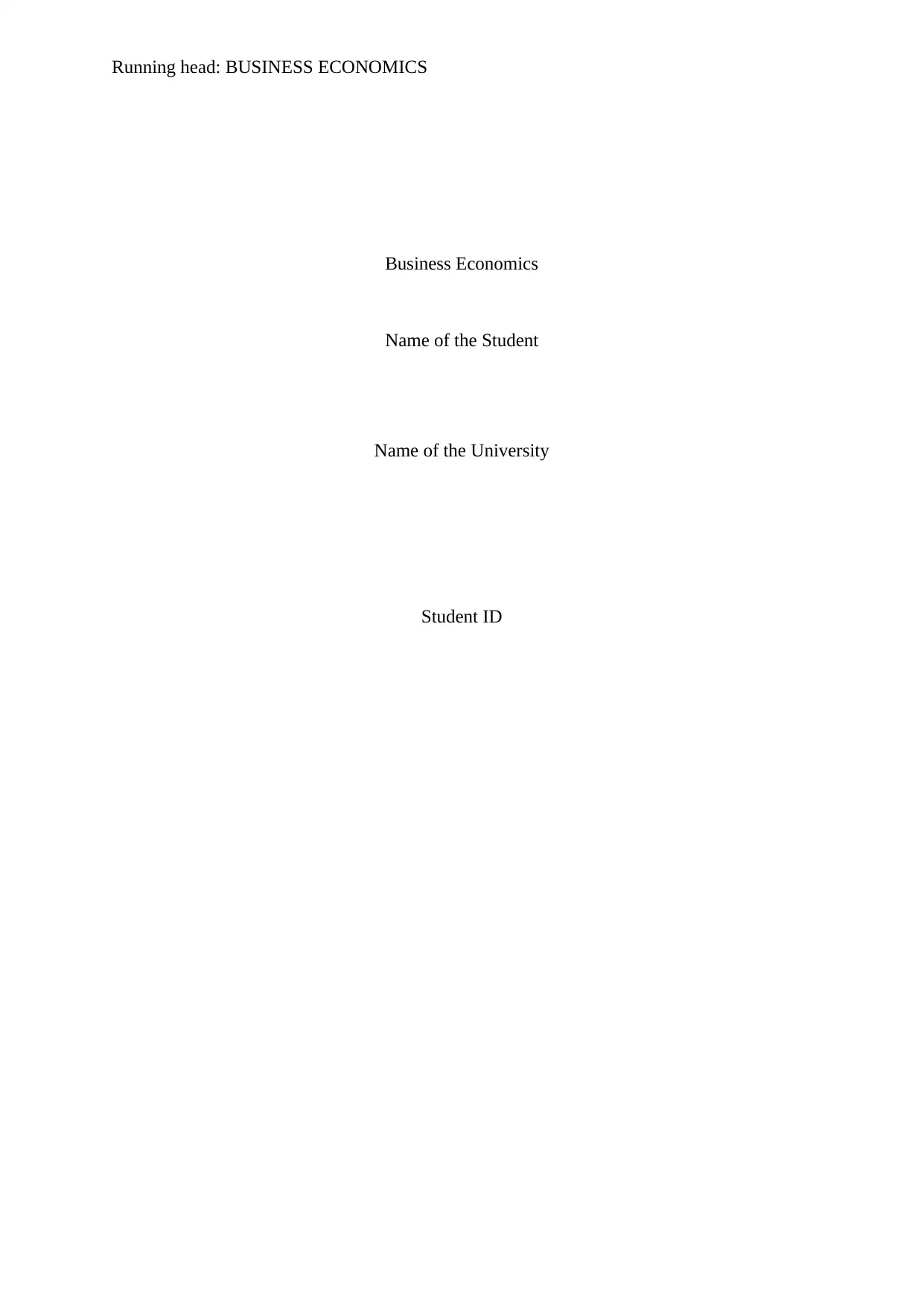
Running head: BUSINESS ECONOMICS
Business Economics
Name of the Student
Name of the University
Student ID
Business Economics
Name of the Student
Name of the University
Student ID
Paraphrase This Document
Need a fresh take? Get an instant paraphrase of this document with our AI Paraphraser
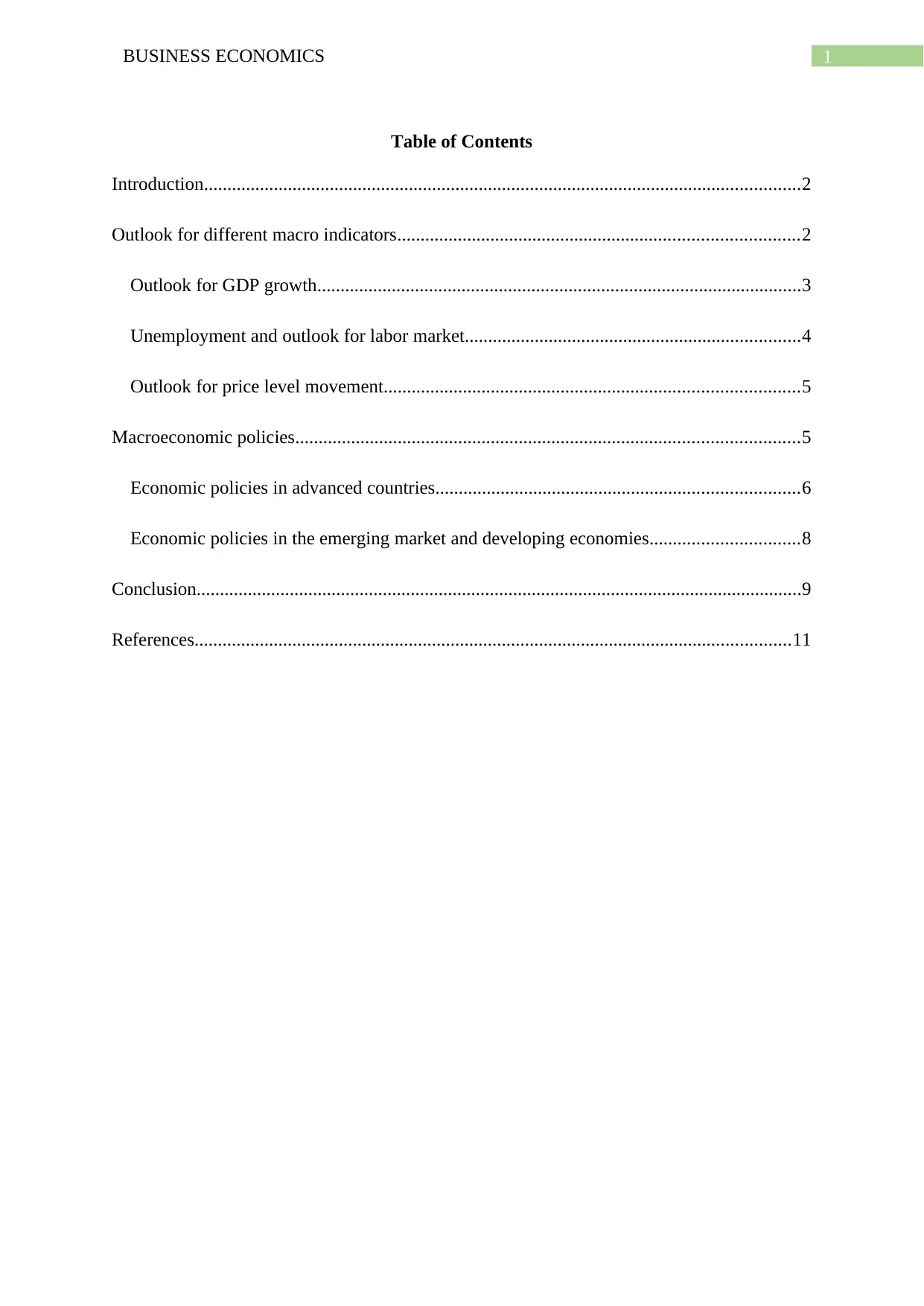
1BUSINESS ECONOMICS
Table of Contents
Introduction................................................................................................................................2
Outlook for different macro indicators......................................................................................2
Outlook for GDP growth........................................................................................................3
Unemployment and outlook for labor market........................................................................4
Outlook for price level movement.........................................................................................5
Macroeconomic policies............................................................................................................5
Economic policies in advanced countries..............................................................................6
Economic policies in the emerging market and developing economies................................8
Conclusion..................................................................................................................................9
References................................................................................................................................11
Table of Contents
Introduction................................................................................................................................2
Outlook for different macro indicators......................................................................................2
Outlook for GDP growth........................................................................................................3
Unemployment and outlook for labor market........................................................................4
Outlook for price level movement.........................................................................................5
Macroeconomic policies............................................................................................................5
Economic policies in advanced countries..............................................................................6
Economic policies in the emerging market and developing economies................................8
Conclusion..................................................................................................................................9
References................................................................................................................................11
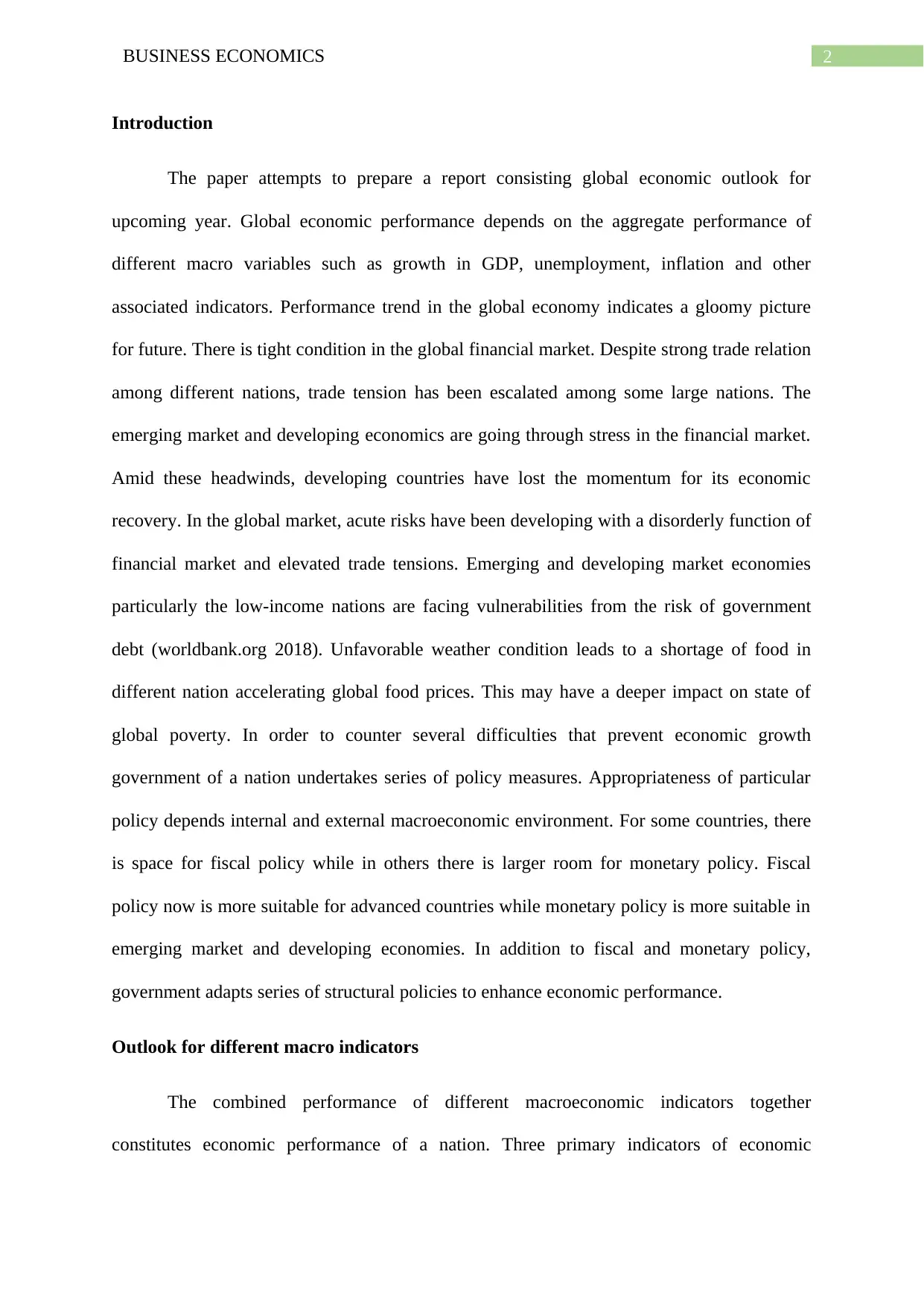
2BUSINESS ECONOMICS
Introduction
The paper attempts to prepare a report consisting global economic outlook for
upcoming year. Global economic performance depends on the aggregate performance of
different macro variables such as growth in GDP, unemployment, inflation and other
associated indicators. Performance trend in the global economy indicates a gloomy picture
for future. There is tight condition in the global financial market. Despite strong trade relation
among different nations, trade tension has been escalated among some large nations. The
emerging market and developing economics are going through stress in the financial market.
Amid these headwinds, developing countries have lost the momentum for its economic
recovery. In the global market, acute risks have been developing with a disorderly function of
financial market and elevated trade tensions. Emerging and developing market economies
particularly the low-income nations are facing vulnerabilities from the risk of government
debt (worldbank.org 2018). Unfavorable weather condition leads to a shortage of food in
different nation accelerating global food prices. This may have a deeper impact on state of
global poverty. In order to counter several difficulties that prevent economic growth
government of a nation undertakes series of policy measures. Appropriateness of particular
policy depends internal and external macroeconomic environment. For some countries, there
is space for fiscal policy while in others there is larger room for monetary policy. Fiscal
policy now is more suitable for advanced countries while monetary policy is more suitable in
emerging market and developing economies. In addition to fiscal and monetary policy,
government adapts series of structural policies to enhance economic performance.
Outlook for different macro indicators
The combined performance of different macroeconomic indicators together
constitutes economic performance of a nation. Three primary indicators of economic
Introduction
The paper attempts to prepare a report consisting global economic outlook for
upcoming year. Global economic performance depends on the aggregate performance of
different macro variables such as growth in GDP, unemployment, inflation and other
associated indicators. Performance trend in the global economy indicates a gloomy picture
for future. There is tight condition in the global financial market. Despite strong trade relation
among different nations, trade tension has been escalated among some large nations. The
emerging market and developing economics are going through stress in the financial market.
Amid these headwinds, developing countries have lost the momentum for its economic
recovery. In the global market, acute risks have been developing with a disorderly function of
financial market and elevated trade tensions. Emerging and developing market economies
particularly the low-income nations are facing vulnerabilities from the risk of government
debt (worldbank.org 2018). Unfavorable weather condition leads to a shortage of food in
different nation accelerating global food prices. This may have a deeper impact on state of
global poverty. In order to counter several difficulties that prevent economic growth
government of a nation undertakes series of policy measures. Appropriateness of particular
policy depends internal and external macroeconomic environment. For some countries, there
is space for fiscal policy while in others there is larger room for monetary policy. Fiscal
policy now is more suitable for advanced countries while monetary policy is more suitable in
emerging market and developing economies. In addition to fiscal and monetary policy,
government adapts series of structural policies to enhance economic performance.
Outlook for different macro indicators
The combined performance of different macroeconomic indicators together
constitutes economic performance of a nation. Three primary indicators of economic
⊘ This is a preview!⊘
Do you want full access?
Subscribe today to unlock all pages.

Trusted by 1+ million students worldwide
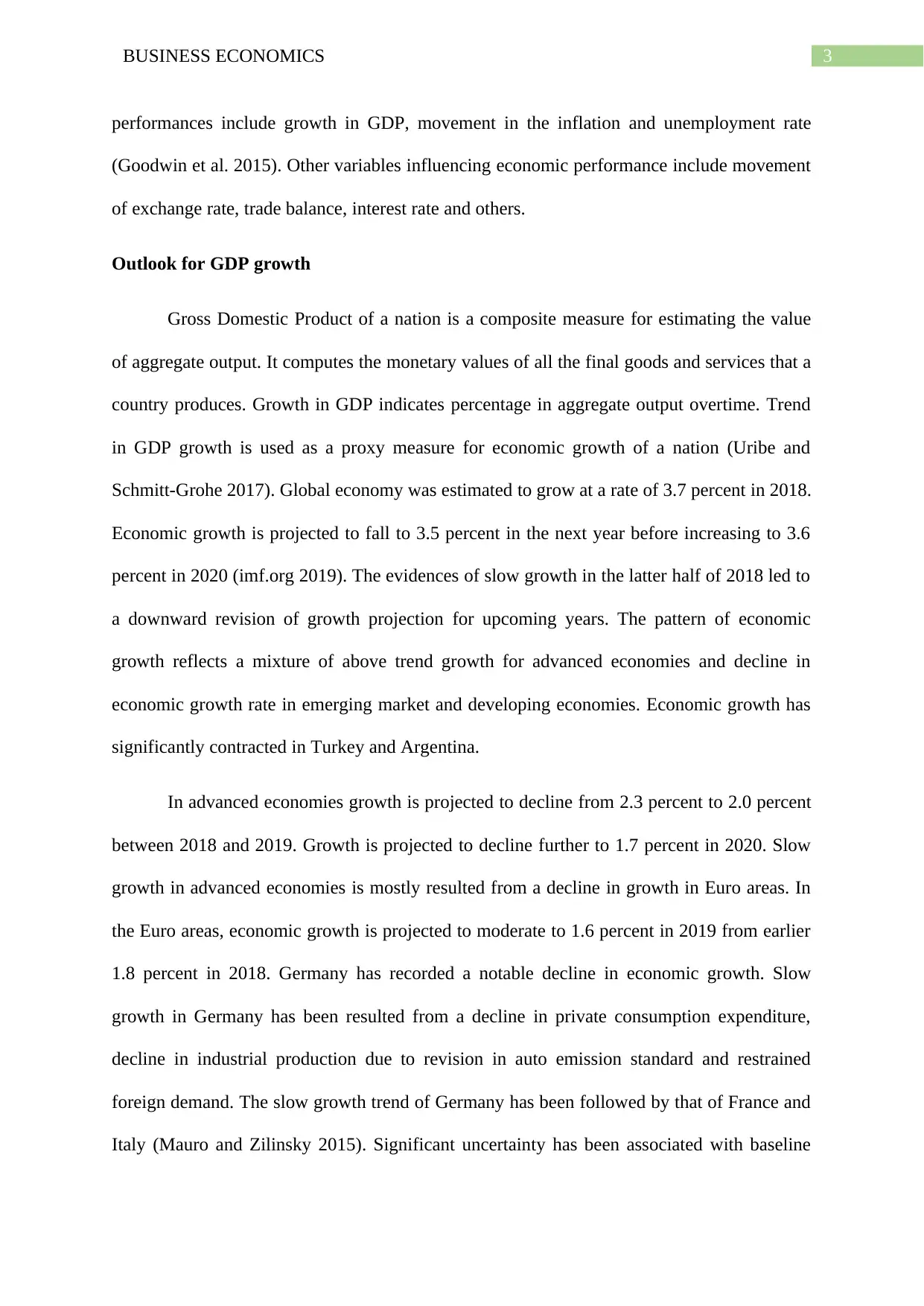
3BUSINESS ECONOMICS
performances include growth in GDP, movement in the inflation and unemployment rate
(Goodwin et al. 2015). Other variables influencing economic performance include movement
of exchange rate, trade balance, interest rate and others.
Outlook for GDP growth
Gross Domestic Product of a nation is a composite measure for estimating the value
of aggregate output. It computes the monetary values of all the final goods and services that a
country produces. Growth in GDP indicates percentage in aggregate output overtime. Trend
in GDP growth is used as a proxy measure for economic growth of a nation (Uribe and
Schmitt-Grohe 2017). Global economy was estimated to grow at a rate of 3.7 percent in 2018.
Economic growth is projected to fall to 3.5 percent in the next year before increasing to 3.6
percent in 2020 (imf.org 2019). The evidences of slow growth in the latter half of 2018 led to
a downward revision of growth projection for upcoming years. The pattern of economic
growth reflects a mixture of above trend growth for advanced economies and decline in
economic growth rate in emerging market and developing economies. Economic growth has
significantly contracted in Turkey and Argentina.
In advanced economies growth is projected to decline from 2.3 percent to 2.0 percent
between 2018 and 2019. Growth is projected to decline further to 1.7 percent in 2020. Slow
growth in advanced economies is mostly resulted from a decline in growth in Euro areas. In
the Euro areas, economic growth is projected to moderate to 1.6 percent in 2019 from earlier
1.8 percent in 2018. Germany has recorded a notable decline in economic growth. Slow
growth in Germany has been resulted from a decline in private consumption expenditure,
decline in industrial production due to revision in auto emission standard and restrained
foreign demand. The slow growth trend of Germany has been followed by that of France and
Italy (Mauro and Zilinsky 2015). Significant uncertainty has been associated with baseline
performances include growth in GDP, movement in the inflation and unemployment rate
(Goodwin et al. 2015). Other variables influencing economic performance include movement
of exchange rate, trade balance, interest rate and others.
Outlook for GDP growth
Gross Domestic Product of a nation is a composite measure for estimating the value
of aggregate output. It computes the monetary values of all the final goods and services that a
country produces. Growth in GDP indicates percentage in aggregate output overtime. Trend
in GDP growth is used as a proxy measure for economic growth of a nation (Uribe and
Schmitt-Grohe 2017). Global economy was estimated to grow at a rate of 3.7 percent in 2018.
Economic growth is projected to fall to 3.5 percent in the next year before increasing to 3.6
percent in 2020 (imf.org 2019). The evidences of slow growth in the latter half of 2018 led to
a downward revision of growth projection for upcoming years. The pattern of economic
growth reflects a mixture of above trend growth for advanced economies and decline in
economic growth rate in emerging market and developing economies. Economic growth has
significantly contracted in Turkey and Argentina.
In advanced economies growth is projected to decline from 2.3 percent to 2.0 percent
between 2018 and 2019. Growth is projected to decline further to 1.7 percent in 2020. Slow
growth in advanced economies is mostly resulted from a decline in growth in Euro areas. In
the Euro areas, economic growth is projected to moderate to 1.6 percent in 2019 from earlier
1.8 percent in 2018. Germany has recorded a notable decline in economic growth. Slow
growth in Germany has been resulted from a decline in private consumption expenditure,
decline in industrial production due to revision in auto emission standard and restrained
foreign demand. The slow growth trend of Germany has been followed by that of France and
Italy (Mauro and Zilinsky 2015). Significant uncertainty has been associated with baseline
Paraphrase This Document
Need a fresh take? Get an instant paraphrase of this document with our AI Paraphraser
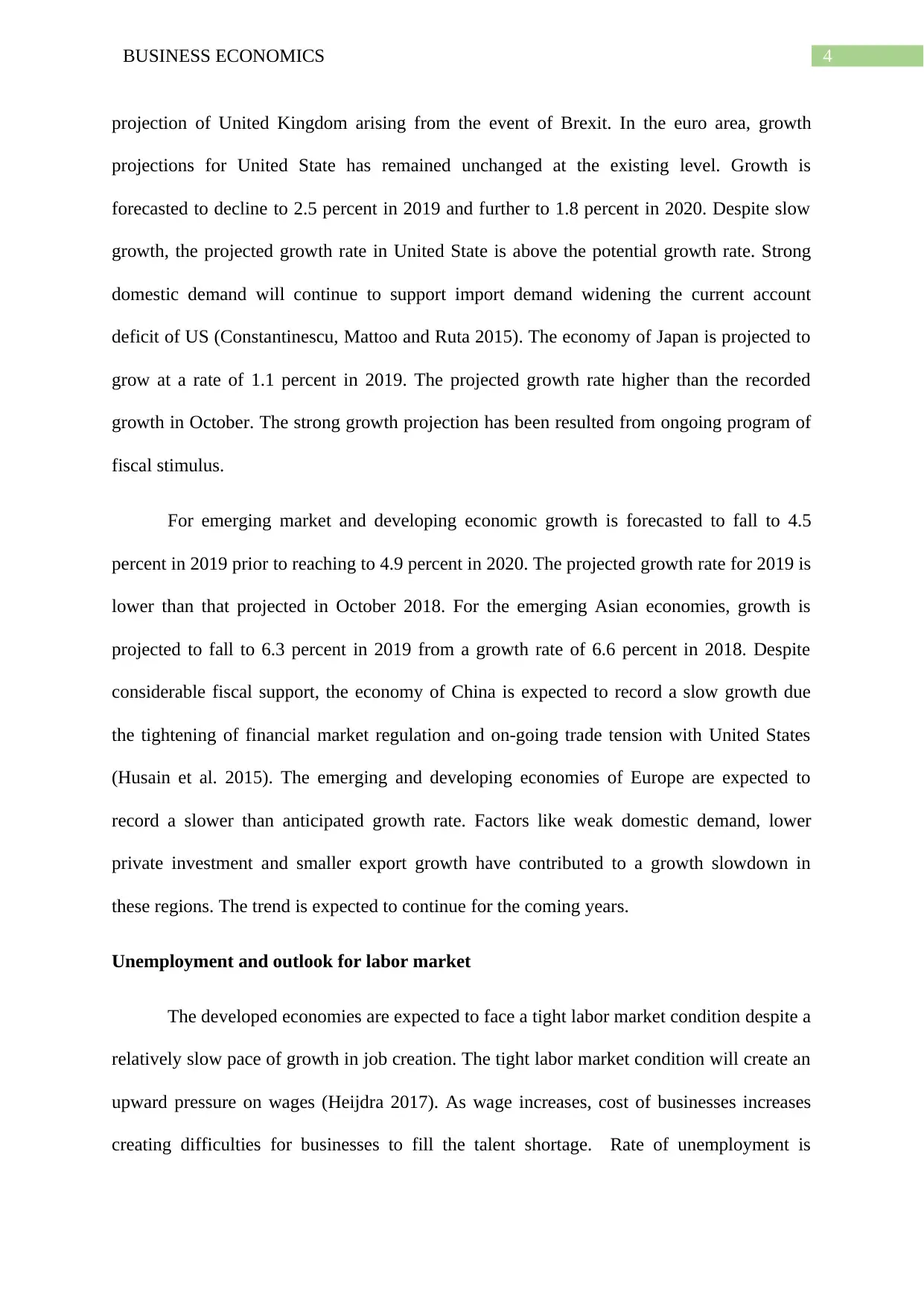
4BUSINESS ECONOMICS
projection of United Kingdom arising from the event of Brexit. In the euro area, growth
projections for United State has remained unchanged at the existing level. Growth is
forecasted to decline to 2.5 percent in 2019 and further to 1.8 percent in 2020. Despite slow
growth, the projected growth rate in United State is above the potential growth rate. Strong
domestic demand will continue to support import demand widening the current account
deficit of US (Constantinescu, Mattoo and Ruta 2015). The economy of Japan is projected to
grow at a rate of 1.1 percent in 2019. The projected growth rate higher than the recorded
growth in October. The strong growth projection has been resulted from ongoing program of
fiscal stimulus.
For emerging market and developing economic growth is forecasted to fall to 4.5
percent in 2019 prior to reaching to 4.9 percent in 2020. The projected growth rate for 2019 is
lower than that projected in October 2018. For the emerging Asian economies, growth is
projected to fall to 6.3 percent in 2019 from a growth rate of 6.6 percent in 2018. Despite
considerable fiscal support, the economy of China is expected to record a slow growth due
the tightening of financial market regulation and on-going trade tension with United States
(Husain et al. 2015). The emerging and developing economies of Europe are expected to
record a slower than anticipated growth rate. Factors like weak domestic demand, lower
private investment and smaller export growth have contributed to a growth slowdown in
these regions. The trend is expected to continue for the coming years.
Unemployment and outlook for labor market
The developed economies are expected to face a tight labor market condition despite a
relatively slow pace of growth in job creation. The tight labor market condition will create an
upward pressure on wages (Heijdra 2017). As wage increases, cost of businesses increases
creating difficulties for businesses to fill the talent shortage. Rate of unemployment is
projection of United Kingdom arising from the event of Brexit. In the euro area, growth
projections for United State has remained unchanged at the existing level. Growth is
forecasted to decline to 2.5 percent in 2019 and further to 1.8 percent in 2020. Despite slow
growth, the projected growth rate in United State is above the potential growth rate. Strong
domestic demand will continue to support import demand widening the current account
deficit of US (Constantinescu, Mattoo and Ruta 2015). The economy of Japan is projected to
grow at a rate of 1.1 percent in 2019. The projected growth rate higher than the recorded
growth in October. The strong growth projection has been resulted from ongoing program of
fiscal stimulus.
For emerging market and developing economic growth is forecasted to fall to 4.5
percent in 2019 prior to reaching to 4.9 percent in 2020. The projected growth rate for 2019 is
lower than that projected in October 2018. For the emerging Asian economies, growth is
projected to fall to 6.3 percent in 2019 from a growth rate of 6.6 percent in 2018. Despite
considerable fiscal support, the economy of China is expected to record a slow growth due
the tightening of financial market regulation and on-going trade tension with United States
(Husain et al. 2015). The emerging and developing economies of Europe are expected to
record a slower than anticipated growth rate. Factors like weak domestic demand, lower
private investment and smaller export growth have contributed to a growth slowdown in
these regions. The trend is expected to continue for the coming years.
Unemployment and outlook for labor market
The developed economies are expected to face a tight labor market condition despite a
relatively slow pace of growth in job creation. The tight labor market condition will create an
upward pressure on wages (Heijdra 2017). As wage increases, cost of businesses increases
creating difficulties for businesses to fill the talent shortage. Rate of unemployment is
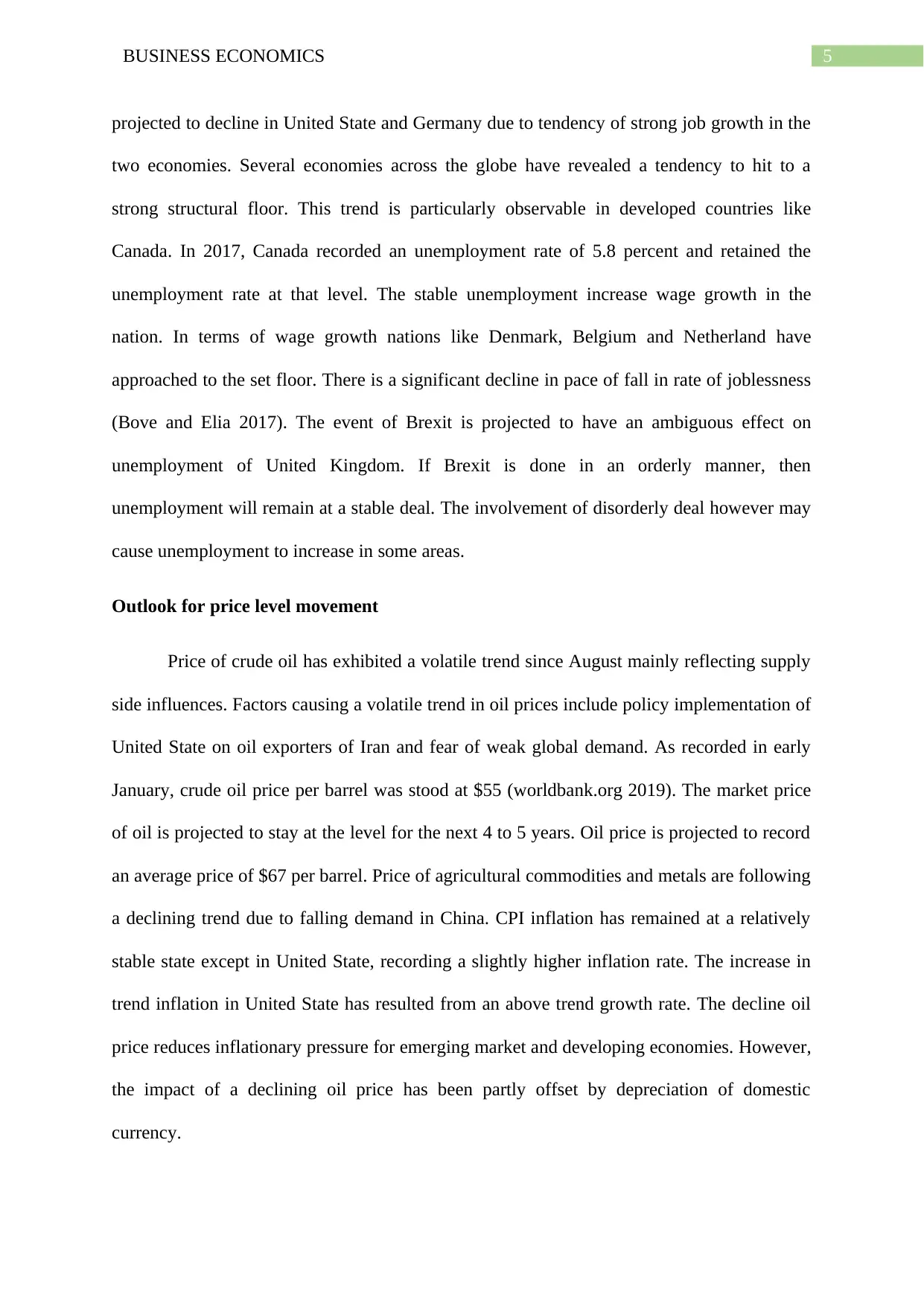
5BUSINESS ECONOMICS
projected to decline in United State and Germany due to tendency of strong job growth in the
two economies. Several economies across the globe have revealed a tendency to hit to a
strong structural floor. This trend is particularly observable in developed countries like
Canada. In 2017, Canada recorded an unemployment rate of 5.8 percent and retained the
unemployment rate at that level. The stable unemployment increase wage growth in the
nation. In terms of wage growth nations like Denmark, Belgium and Netherland have
approached to the set floor. There is a significant decline in pace of fall in rate of joblessness
(Bove and Elia 2017). The event of Brexit is projected to have an ambiguous effect on
unemployment of United Kingdom. If Brexit is done in an orderly manner, then
unemployment will remain at a stable deal. The involvement of disorderly deal however may
cause unemployment to increase in some areas.
Outlook for price level movement
Price of crude oil has exhibited a volatile trend since August mainly reflecting supply
side influences. Factors causing a volatile trend in oil prices include policy implementation of
United State on oil exporters of Iran and fear of weak global demand. As recorded in early
January, crude oil price per barrel was stood at $55 (worldbank.org 2019). The market price
of oil is projected to stay at the level for the next 4 to 5 years. Oil price is projected to record
an average price of $67 per barrel. Price of agricultural commodities and metals are following
a declining trend due to falling demand in China. CPI inflation has remained at a relatively
stable state except in United State, recording a slightly higher inflation rate. The increase in
trend inflation in United State has resulted from an above trend growth rate. The decline oil
price reduces inflationary pressure for emerging market and developing economies. However,
the impact of a declining oil price has been partly offset by depreciation of domestic
currency.
projected to decline in United State and Germany due to tendency of strong job growth in the
two economies. Several economies across the globe have revealed a tendency to hit to a
strong structural floor. This trend is particularly observable in developed countries like
Canada. In 2017, Canada recorded an unemployment rate of 5.8 percent and retained the
unemployment rate at that level. The stable unemployment increase wage growth in the
nation. In terms of wage growth nations like Denmark, Belgium and Netherland have
approached to the set floor. There is a significant decline in pace of fall in rate of joblessness
(Bove and Elia 2017). The event of Brexit is projected to have an ambiguous effect on
unemployment of United Kingdom. If Brexit is done in an orderly manner, then
unemployment will remain at a stable deal. The involvement of disorderly deal however may
cause unemployment to increase in some areas.
Outlook for price level movement
Price of crude oil has exhibited a volatile trend since August mainly reflecting supply
side influences. Factors causing a volatile trend in oil prices include policy implementation of
United State on oil exporters of Iran and fear of weak global demand. As recorded in early
January, crude oil price per barrel was stood at $55 (worldbank.org 2019). The market price
of oil is projected to stay at the level for the next 4 to 5 years. Oil price is projected to record
an average price of $67 per barrel. Price of agricultural commodities and metals are following
a declining trend due to falling demand in China. CPI inflation has remained at a relatively
stable state except in United State, recording a slightly higher inflation rate. The increase in
trend inflation in United State has resulted from an above trend growth rate. The decline oil
price reduces inflationary pressure for emerging market and developing economies. However,
the impact of a declining oil price has been partly offset by depreciation of domestic
currency.
⊘ This is a preview!⊘
Do you want full access?
Subscribe today to unlock all pages.

Trusted by 1+ million students worldwide
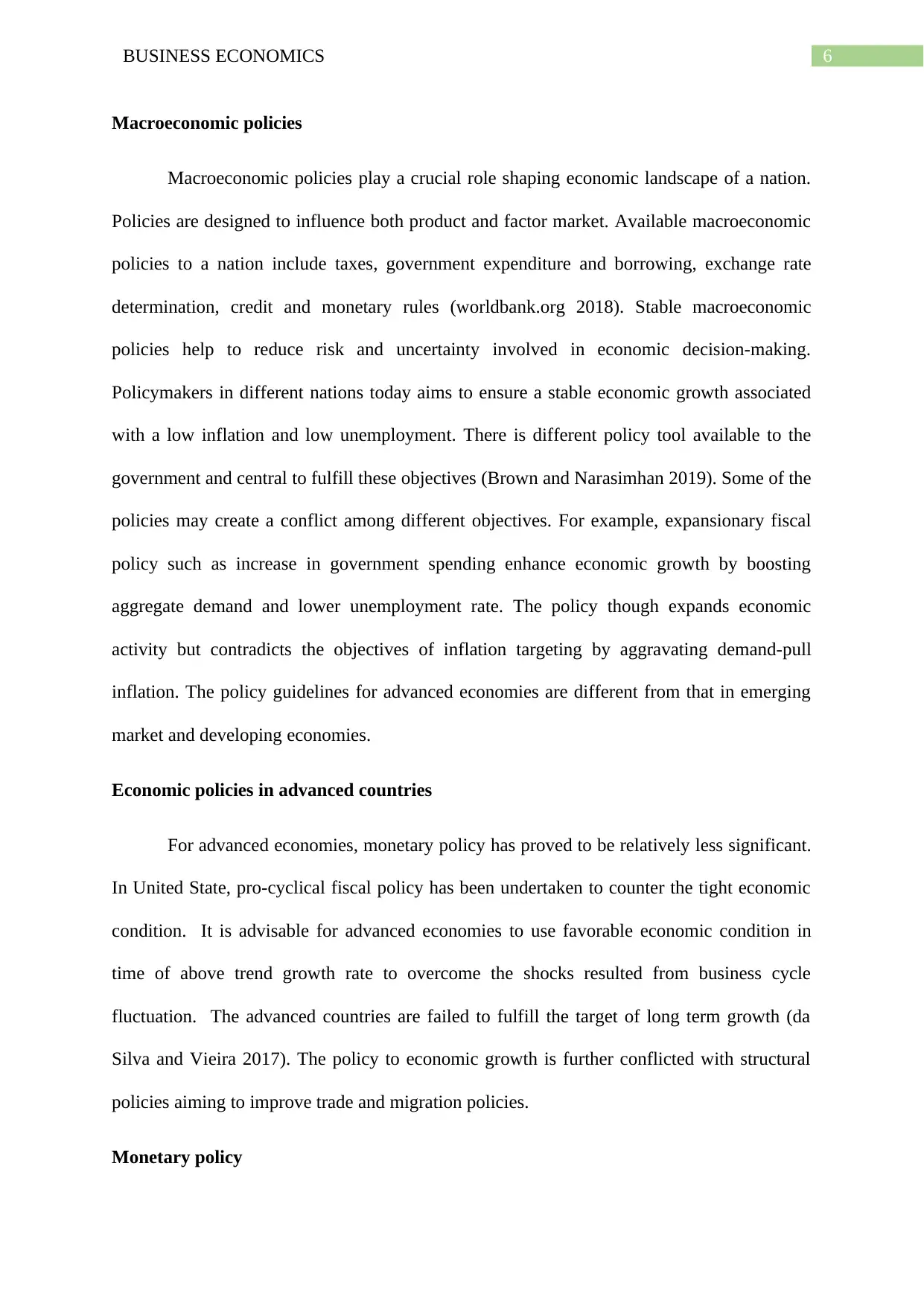
6BUSINESS ECONOMICS
Macroeconomic policies
Macroeconomic policies play a crucial role shaping economic landscape of a nation.
Policies are designed to influence both product and factor market. Available macroeconomic
policies to a nation include taxes, government expenditure and borrowing, exchange rate
determination, credit and monetary rules (worldbank.org 2018). Stable macroeconomic
policies help to reduce risk and uncertainty involved in economic decision-making.
Policymakers in different nations today aims to ensure a stable economic growth associated
with a low inflation and low unemployment. There is different policy tool available to the
government and central to fulfill these objectives (Brown and Narasimhan 2019). Some of the
policies may create a conflict among different objectives. For example, expansionary fiscal
policy such as increase in government spending enhance economic growth by boosting
aggregate demand and lower unemployment rate. The policy though expands economic
activity but contradicts the objectives of inflation targeting by aggravating demand-pull
inflation. The policy guidelines for advanced economies are different from that in emerging
market and developing economies.
Economic policies in advanced countries
For advanced economies, monetary policy has proved to be relatively less significant.
In United State, pro-cyclical fiscal policy has been undertaken to counter the tight economic
condition. It is advisable for advanced economies to use favorable economic condition in
time of above trend growth rate to overcome the shocks resulted from business cycle
fluctuation. The advanced countries are failed to fulfill the target of long term growth (da
Silva and Vieira 2017). The policy to economic growth is further conflicted with structural
policies aiming to improve trade and migration policies.
Monetary policy
Macroeconomic policies
Macroeconomic policies play a crucial role shaping economic landscape of a nation.
Policies are designed to influence both product and factor market. Available macroeconomic
policies to a nation include taxes, government expenditure and borrowing, exchange rate
determination, credit and monetary rules (worldbank.org 2018). Stable macroeconomic
policies help to reduce risk and uncertainty involved in economic decision-making.
Policymakers in different nations today aims to ensure a stable economic growth associated
with a low inflation and low unemployment. There is different policy tool available to the
government and central to fulfill these objectives (Brown and Narasimhan 2019). Some of the
policies may create a conflict among different objectives. For example, expansionary fiscal
policy such as increase in government spending enhance economic growth by boosting
aggregate demand and lower unemployment rate. The policy though expands economic
activity but contradicts the objectives of inflation targeting by aggravating demand-pull
inflation. The policy guidelines for advanced economies are different from that in emerging
market and developing economies.
Economic policies in advanced countries
For advanced economies, monetary policy has proved to be relatively less significant.
In United State, pro-cyclical fiscal policy has been undertaken to counter the tight economic
condition. It is advisable for advanced economies to use favorable economic condition in
time of above trend growth rate to overcome the shocks resulted from business cycle
fluctuation. The advanced countries are failed to fulfill the target of long term growth (da
Silva and Vieira 2017). The policy to economic growth is further conflicted with structural
policies aiming to improve trade and migration policies.
Monetary policy
Paraphrase This Document
Need a fresh take? Get an instant paraphrase of this document with our AI Paraphraser
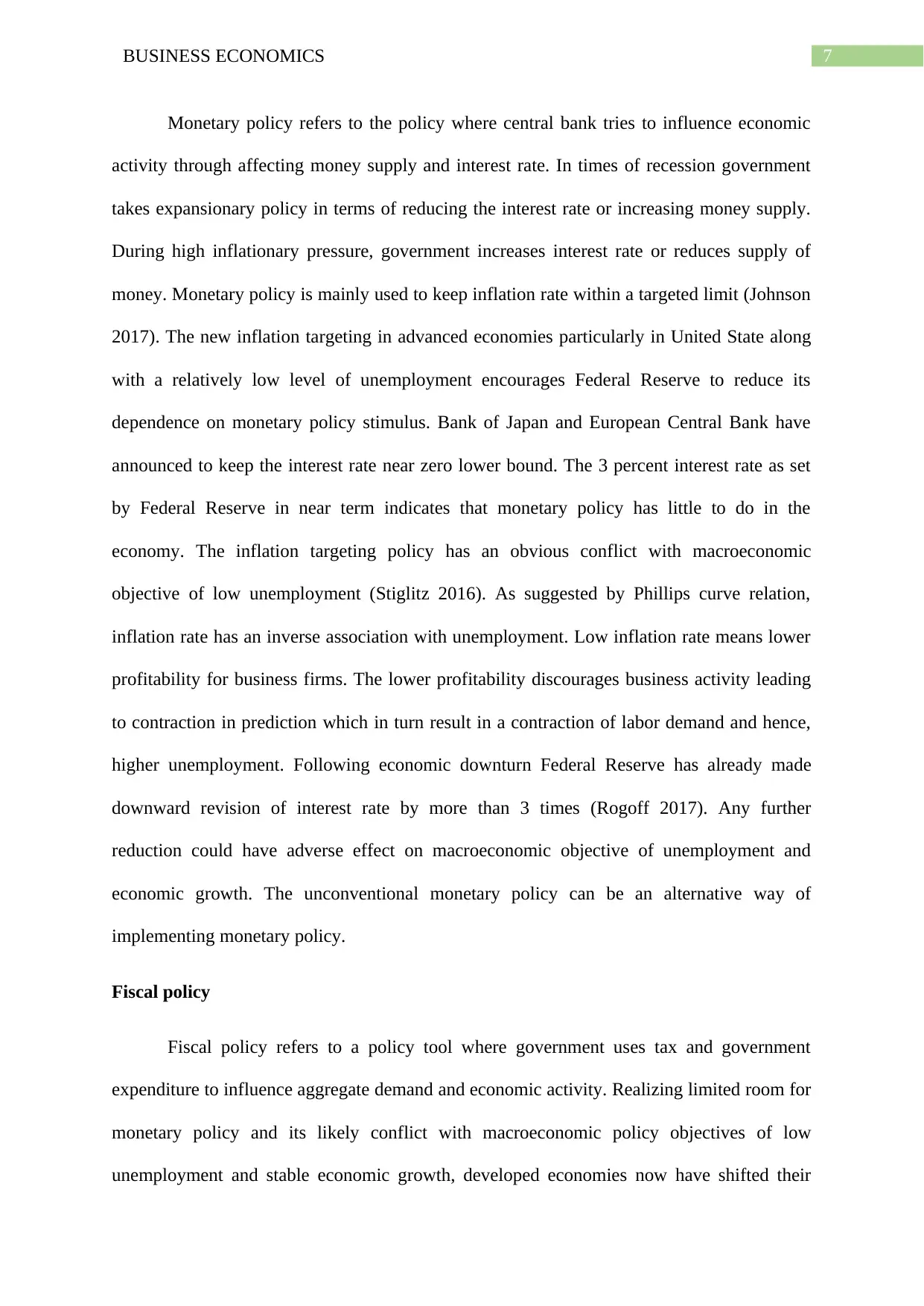
7BUSINESS ECONOMICS
Monetary policy refers to the policy where central bank tries to influence economic
activity through affecting money supply and interest rate. In times of recession government
takes expansionary policy in terms of reducing the interest rate or increasing money supply.
During high inflationary pressure, government increases interest rate or reduces supply of
money. Monetary policy is mainly used to keep inflation rate within a targeted limit (Johnson
2017). The new inflation targeting in advanced economies particularly in United State along
with a relatively low level of unemployment encourages Federal Reserve to reduce its
dependence on monetary policy stimulus. Bank of Japan and European Central Bank have
announced to keep the interest rate near zero lower bound. The 3 percent interest rate as set
by Federal Reserve in near term indicates that monetary policy has little to do in the
economy. The inflation targeting policy has an obvious conflict with macroeconomic
objective of low unemployment (Stiglitz 2016). As suggested by Phillips curve relation,
inflation rate has an inverse association with unemployment. Low inflation rate means lower
profitability for business firms. The lower profitability discourages business activity leading
to contraction in prediction which in turn result in a contraction of labor demand and hence,
higher unemployment. Following economic downturn Federal Reserve has already made
downward revision of interest rate by more than 3 times (Rogoff 2017). Any further
reduction could have adverse effect on macroeconomic objective of unemployment and
economic growth. The unconventional monetary policy can be an alternative way of
implementing monetary policy.
Fiscal policy
Fiscal policy refers to a policy tool where government uses tax and government
expenditure to influence aggregate demand and economic activity. Realizing limited room for
monetary policy and its likely conflict with macroeconomic policy objectives of low
unemployment and stable economic growth, developed economies now have shifted their
Monetary policy refers to the policy where central bank tries to influence economic
activity through affecting money supply and interest rate. In times of recession government
takes expansionary policy in terms of reducing the interest rate or increasing money supply.
During high inflationary pressure, government increases interest rate or reduces supply of
money. Monetary policy is mainly used to keep inflation rate within a targeted limit (Johnson
2017). The new inflation targeting in advanced economies particularly in United State along
with a relatively low level of unemployment encourages Federal Reserve to reduce its
dependence on monetary policy stimulus. Bank of Japan and European Central Bank have
announced to keep the interest rate near zero lower bound. The 3 percent interest rate as set
by Federal Reserve in near term indicates that monetary policy has little to do in the
economy. The inflation targeting policy has an obvious conflict with macroeconomic
objective of low unemployment (Stiglitz 2016). As suggested by Phillips curve relation,
inflation rate has an inverse association with unemployment. Low inflation rate means lower
profitability for business firms. The lower profitability discourages business activity leading
to contraction in prediction which in turn result in a contraction of labor demand and hence,
higher unemployment. Following economic downturn Federal Reserve has already made
downward revision of interest rate by more than 3 times (Rogoff 2017). Any further
reduction could have adverse effect on macroeconomic objective of unemployment and
economic growth. The unconventional monetary policy can be an alternative way of
implementing monetary policy.
Fiscal policy
Fiscal policy refers to a policy tool where government uses tax and government
expenditure to influence aggregate demand and economic activity. Realizing limited room for
monetary policy and its likely conflict with macroeconomic policy objectives of low
unemployment and stable economic growth, developed economies now have shifted their
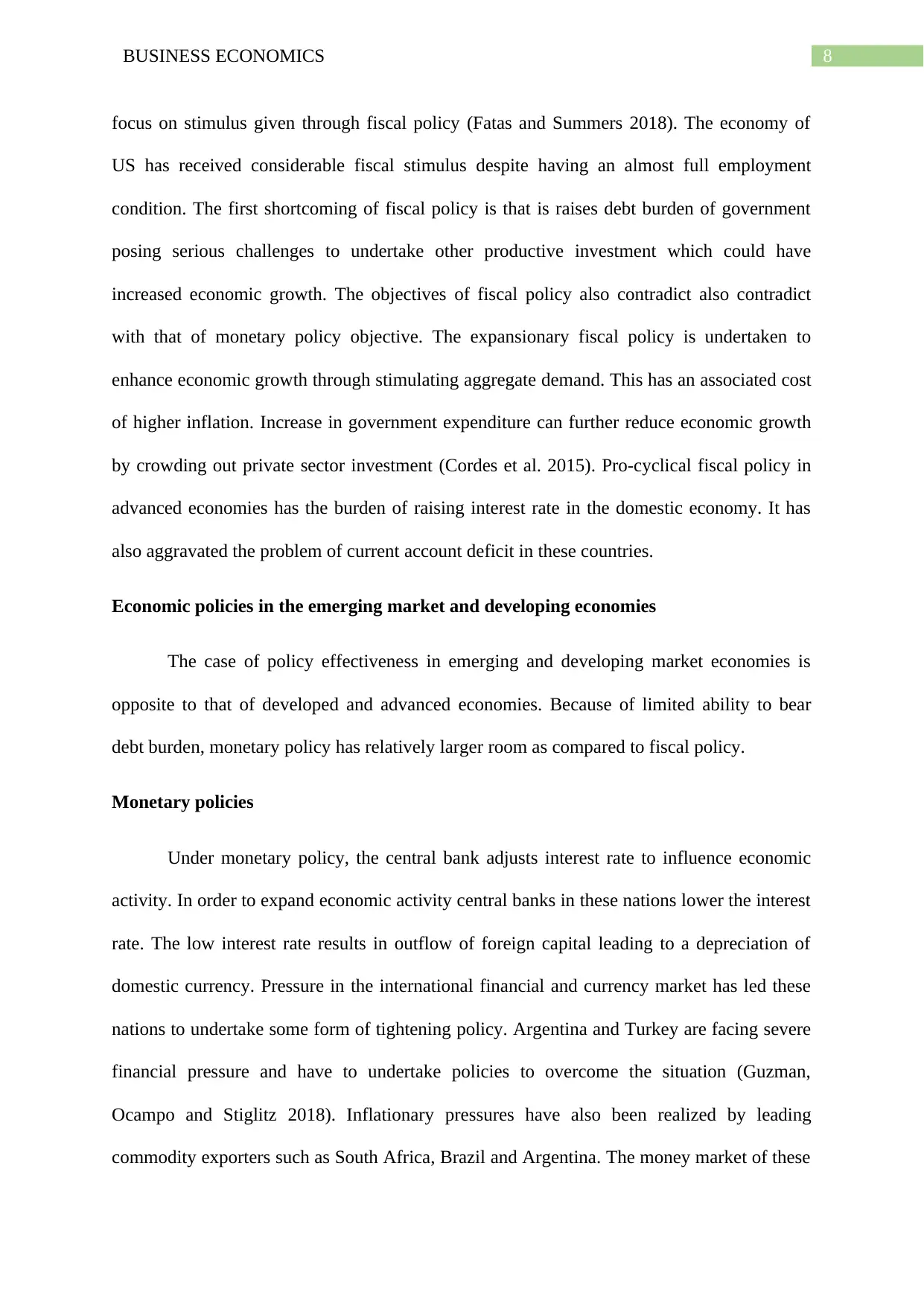
8BUSINESS ECONOMICS
focus on stimulus given through fiscal policy (Fatas and Summers 2018). The economy of
US has received considerable fiscal stimulus despite having an almost full employment
condition. The first shortcoming of fiscal policy is that is raises debt burden of government
posing serious challenges to undertake other productive investment which could have
increased economic growth. The objectives of fiscal policy also contradict also contradict
with that of monetary policy objective. The expansionary fiscal policy is undertaken to
enhance economic growth through stimulating aggregate demand. This has an associated cost
of higher inflation. Increase in government expenditure can further reduce economic growth
by crowding out private sector investment (Cordes et al. 2015). Pro-cyclical fiscal policy in
advanced economies has the burden of raising interest rate in the domestic economy. It has
also aggravated the problem of current account deficit in these countries.
Economic policies in the emerging market and developing economies
The case of policy effectiveness in emerging and developing market economies is
opposite to that of developed and advanced economies. Because of limited ability to bear
debt burden, monetary policy has relatively larger room as compared to fiscal policy.
Monetary policies
Under monetary policy, the central bank adjusts interest rate to influence economic
activity. In order to expand economic activity central banks in these nations lower the interest
rate. The low interest rate results in outflow of foreign capital leading to a depreciation of
domestic currency. Pressure in the international financial and currency market has led these
nations to undertake some form of tightening policy. Argentina and Turkey are facing severe
financial pressure and have to undertake policies to overcome the situation (Guzman,
Ocampo and Stiglitz 2018). Inflationary pressures have also been realized by leading
commodity exporters such as South Africa, Brazil and Argentina. The money market of these
focus on stimulus given through fiscal policy (Fatas and Summers 2018). The economy of
US has received considerable fiscal stimulus despite having an almost full employment
condition. The first shortcoming of fiscal policy is that is raises debt burden of government
posing serious challenges to undertake other productive investment which could have
increased economic growth. The objectives of fiscal policy also contradict also contradict
with that of monetary policy objective. The expansionary fiscal policy is undertaken to
enhance economic growth through stimulating aggregate demand. This has an associated cost
of higher inflation. Increase in government expenditure can further reduce economic growth
by crowding out private sector investment (Cordes et al. 2015). Pro-cyclical fiscal policy in
advanced economies has the burden of raising interest rate in the domestic economy. It has
also aggravated the problem of current account deficit in these countries.
Economic policies in the emerging market and developing economies
The case of policy effectiveness in emerging and developing market economies is
opposite to that of developed and advanced economies. Because of limited ability to bear
debt burden, monetary policy has relatively larger room as compared to fiscal policy.
Monetary policies
Under monetary policy, the central bank adjusts interest rate to influence economic
activity. In order to expand economic activity central banks in these nations lower the interest
rate. The low interest rate results in outflow of foreign capital leading to a depreciation of
domestic currency. Pressure in the international financial and currency market has led these
nations to undertake some form of tightening policy. Argentina and Turkey are facing severe
financial pressure and have to undertake policies to overcome the situation (Guzman,
Ocampo and Stiglitz 2018). Inflationary pressures have also been realized by leading
commodity exporters such as South Africa, Brazil and Argentina. The money market of these
⊘ This is a preview!⊘
Do you want full access?
Subscribe today to unlock all pages.

Trusted by 1+ million students worldwide
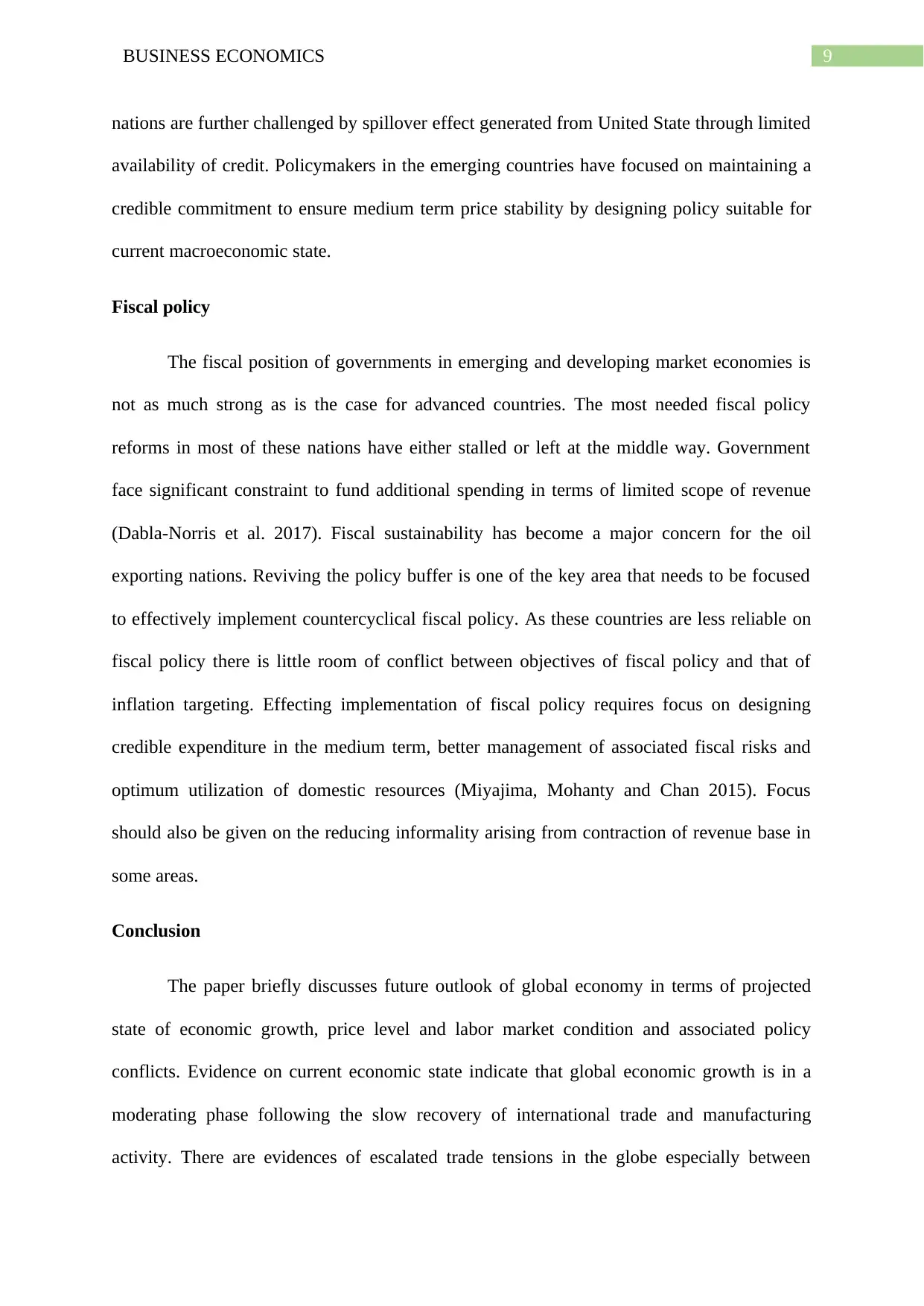
9BUSINESS ECONOMICS
nations are further challenged by spillover effect generated from United State through limited
availability of credit. Policymakers in the emerging countries have focused on maintaining a
credible commitment to ensure medium term price stability by designing policy suitable for
current macroeconomic state.
Fiscal policy
The fiscal position of governments in emerging and developing market economies is
not as much strong as is the case for advanced countries. The most needed fiscal policy
reforms in most of these nations have either stalled or left at the middle way. Government
face significant constraint to fund additional spending in terms of limited scope of revenue
(Dabla-Norris et al. 2017). Fiscal sustainability has become a major concern for the oil
exporting nations. Reviving the policy buffer is one of the key area that needs to be focused
to effectively implement countercyclical fiscal policy. As these countries are less reliable on
fiscal policy there is little room of conflict between objectives of fiscal policy and that of
inflation targeting. Effecting implementation of fiscal policy requires focus on designing
credible expenditure in the medium term, better management of associated fiscal risks and
optimum utilization of domestic resources (Miyajima, Mohanty and Chan 2015). Focus
should also be given on the reducing informality arising from contraction of revenue base in
some areas.
Conclusion
The paper briefly discusses future outlook of global economy in terms of projected
state of economic growth, price level and labor market condition and associated policy
conflicts. Evidence on current economic state indicate that global economic growth is in a
moderating phase following the slow recovery of international trade and manufacturing
activity. There are evidences of escalated trade tensions in the globe especially between
nations are further challenged by spillover effect generated from United State through limited
availability of credit. Policymakers in the emerging countries have focused on maintaining a
credible commitment to ensure medium term price stability by designing policy suitable for
current macroeconomic state.
Fiscal policy
The fiscal position of governments in emerging and developing market economies is
not as much strong as is the case for advanced countries. The most needed fiscal policy
reforms in most of these nations have either stalled or left at the middle way. Government
face significant constraint to fund additional spending in terms of limited scope of revenue
(Dabla-Norris et al. 2017). Fiscal sustainability has become a major concern for the oil
exporting nations. Reviving the policy buffer is one of the key area that needs to be focused
to effectively implement countercyclical fiscal policy. As these countries are less reliable on
fiscal policy there is little room of conflict between objectives of fiscal policy and that of
inflation targeting. Effecting implementation of fiscal policy requires focus on designing
credible expenditure in the medium term, better management of associated fiscal risks and
optimum utilization of domestic resources (Miyajima, Mohanty and Chan 2015). Focus
should also be given on the reducing informality arising from contraction of revenue base in
some areas.
Conclusion
The paper briefly discusses future outlook of global economy in terms of projected
state of economic growth, price level and labor market condition and associated policy
conflicts. Evidence on current economic state indicate that global economic growth is in a
moderating phase following the slow recovery of international trade and manufacturing
activity. There are evidences of escalated trade tensions in the globe especially between
Paraphrase This Document
Need a fresh take? Get an instant paraphrase of this document with our AI Paraphraser
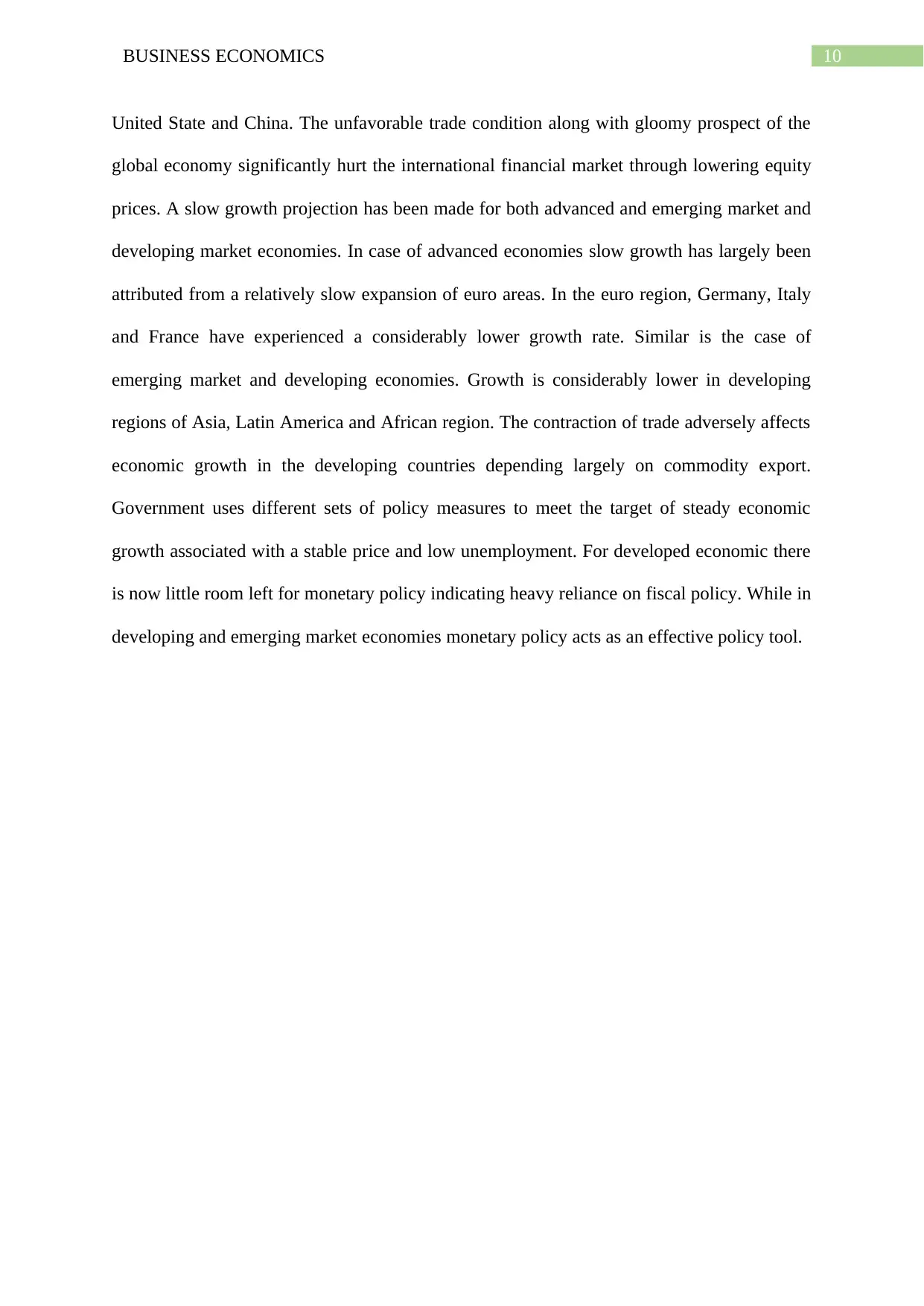
10BUSINESS ECONOMICS
United State and China. The unfavorable trade condition along with gloomy prospect of the
global economy significantly hurt the international financial market through lowering equity
prices. A slow growth projection has been made for both advanced and emerging market and
developing market economies. In case of advanced economies slow growth has largely been
attributed from a relatively slow expansion of euro areas. In the euro region, Germany, Italy
and France have experienced a considerably lower growth rate. Similar is the case of
emerging market and developing economies. Growth is considerably lower in developing
regions of Asia, Latin America and African region. The contraction of trade adversely affects
economic growth in the developing countries depending largely on commodity export.
Government uses different sets of policy measures to meet the target of steady economic
growth associated with a stable price and low unemployment. For developed economic there
is now little room left for monetary policy indicating heavy reliance on fiscal policy. While in
developing and emerging market economies monetary policy acts as an effective policy tool.
United State and China. The unfavorable trade condition along with gloomy prospect of the
global economy significantly hurt the international financial market through lowering equity
prices. A slow growth projection has been made for both advanced and emerging market and
developing market economies. In case of advanced economies slow growth has largely been
attributed from a relatively slow expansion of euro areas. In the euro region, Germany, Italy
and France have experienced a considerably lower growth rate. Similar is the case of
emerging market and developing economies. Growth is considerably lower in developing
regions of Asia, Latin America and African region. The contraction of trade adversely affects
economic growth in the developing countries depending largely on commodity export.
Government uses different sets of policy measures to meet the target of steady economic
growth associated with a stable price and low unemployment. For developed economic there
is now little room left for monetary policy indicating heavy reliance on fiscal policy. While in
developing and emerging market economies monetary policy acts as an effective policy tool.
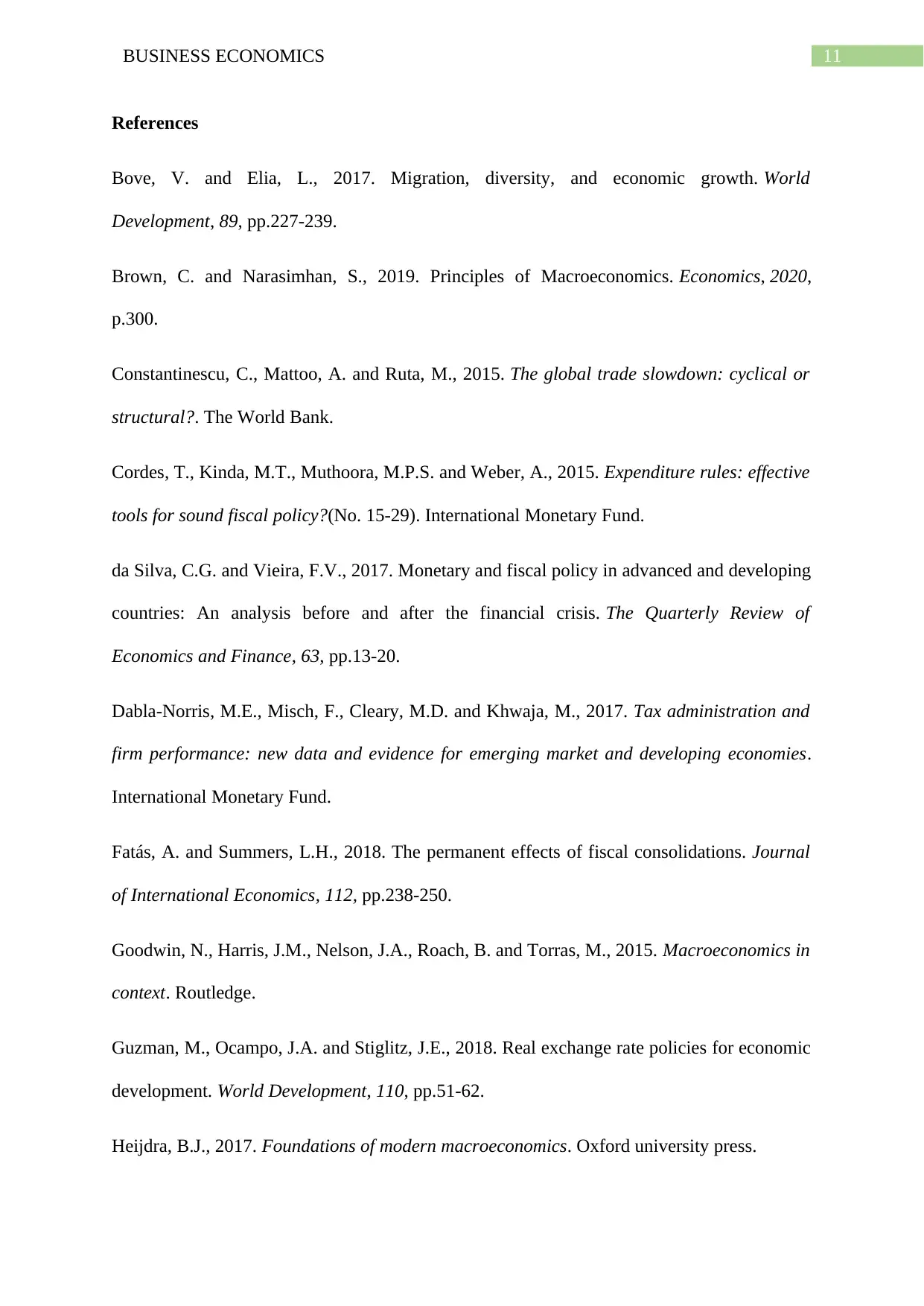
11BUSINESS ECONOMICS
References
Bove, V. and Elia, L., 2017. Migration, diversity, and economic growth. World
Development, 89, pp.227-239.
Brown, C. and Narasimhan, S., 2019. Principles of Macroeconomics. Economics, 2020,
p.300.
Constantinescu, C., Mattoo, A. and Ruta, M., 2015. The global trade slowdown: cyclical or
structural?. The World Bank.
Cordes, T., Kinda, M.T., Muthoora, M.P.S. and Weber, A., 2015. Expenditure rules: effective
tools for sound fiscal policy?(No. 15-29). International Monetary Fund.
da Silva, C.G. and Vieira, F.V., 2017. Monetary and fiscal policy in advanced and developing
countries: An analysis before and after the financial crisis. The Quarterly Review of
Economics and Finance, 63, pp.13-20.
Dabla-Norris, M.E., Misch, F., Cleary, M.D. and Khwaja, M., 2017. Tax administration and
firm performance: new data and evidence for emerging market and developing economies.
International Monetary Fund.
Fatás, A. and Summers, L.H., 2018. The permanent effects of fiscal consolidations. Journal
of International Economics, 112, pp.238-250.
Goodwin, N., Harris, J.M., Nelson, J.A., Roach, B. and Torras, M., 2015. Macroeconomics in
context. Routledge.
Guzman, M., Ocampo, J.A. and Stiglitz, J.E., 2018. Real exchange rate policies for economic
development. World Development, 110, pp.51-62.
Heijdra, B.J., 2017. Foundations of modern macroeconomics. Oxford university press.
References
Bove, V. and Elia, L., 2017. Migration, diversity, and economic growth. World
Development, 89, pp.227-239.
Brown, C. and Narasimhan, S., 2019. Principles of Macroeconomics. Economics, 2020,
p.300.
Constantinescu, C., Mattoo, A. and Ruta, M., 2015. The global trade slowdown: cyclical or
structural?. The World Bank.
Cordes, T., Kinda, M.T., Muthoora, M.P.S. and Weber, A., 2015. Expenditure rules: effective
tools for sound fiscal policy?(No. 15-29). International Monetary Fund.
da Silva, C.G. and Vieira, F.V., 2017. Monetary and fiscal policy in advanced and developing
countries: An analysis before and after the financial crisis. The Quarterly Review of
Economics and Finance, 63, pp.13-20.
Dabla-Norris, M.E., Misch, F., Cleary, M.D. and Khwaja, M., 2017. Tax administration and
firm performance: new data and evidence for emerging market and developing economies.
International Monetary Fund.
Fatás, A. and Summers, L.H., 2018. The permanent effects of fiscal consolidations. Journal
of International Economics, 112, pp.238-250.
Goodwin, N., Harris, J.M., Nelson, J.A., Roach, B. and Torras, M., 2015. Macroeconomics in
context. Routledge.
Guzman, M., Ocampo, J.A. and Stiglitz, J.E., 2018. Real exchange rate policies for economic
development. World Development, 110, pp.51-62.
Heijdra, B.J., 2017. Foundations of modern macroeconomics. Oxford university press.
⊘ This is a preview!⊘
Do you want full access?
Subscribe today to unlock all pages.

Trusted by 1+ million students worldwide
1 out of 14
Related Documents
Your All-in-One AI-Powered Toolkit for Academic Success.
+13062052269
info@desklib.com
Available 24*7 on WhatsApp / Email
![[object Object]](/_next/static/media/star-bottom.7253800d.svg)
Unlock your academic potential
Copyright © 2020–2025 A2Z Services. All Rights Reserved. Developed and managed by ZUCOL.





